With Impressions Chosen from Another Time: Core Technologies and Debitage Production at the Lower Palaeolithic Site of Notarchirico (670-695 ka; layers F to I2)
- PMID: 37675140
- PMCID: PMC10477117
- DOI: 10.1007/s41982-023-00154-y
With Impressions Chosen from Another Time: Core Technologies and Debitage Production at the Lower Palaeolithic Site of Notarchirico (670-695 ka; layers F to I2)
Abstract
The earliest evidence of bifaces in western Europe is dated to the initial phase of the Middle Pleistocene (la Noira, Notarchirico, Moulin Quignon, 700-670 ka), with the findings of Barranc de la Boella (1.0-0.9 Ma) considered to be an earlier local evolution. No transition assemblages are recorded during this time frame, and the "abrupt" appearance of bifaces during this time frame is associated with significant cognitive shifts in human technological behaviours (Acheulean techno-complex). The new investigations conducted at the site of Notarchirico unearthed 30 ka of repeated human occupation (695-670 ka, layers F-I2) during MIS 17, with evidence of bifacial tools in layer G (680 ka) and F along with other heavy-duty implements (LCTs, pebble tools, etc.). Massive production of debitage products realised on local raw materials collected in situ through simple and efficient core technologies characterises a large part of the lithic assemblage with a high ratio of diversified light-duty tools, including modified chert nodules. Despite core and flake assemblages being a recurrent trait of Lower Pleistocene contexts, the increase in retouched implements recorded at the onset of the Middle Pleistocene has been considered a significant technological shift. The technological analysis of the debitage products presented in this work highlights recurrent and systematic technological behaviours of the hominins of Notarchirico-who proved to efficiently overcome the raw materials dimensional constraints-even in the layers without bifaces. This may shed light on the meaning of cultural and behavioural innovation that the Acheulean techno-complex is thought to bring over Europe. It is plausible that given the substantial homogeneity of the lithic strategies within the sequence of Notarchirico, which only the "introduction" of the bifaces in the upper layers seems to interrupt, a supposed behavioural or cultural change in the site might have already occurred in the lowermost portion of the sequence. In this work, we evaluate the degree of change-if any-from a technological perspective by analysing the debitage reduction sequences.
Keywords: Acheulean; Core technologies; Lower Palaeolithic.
© The Author(s) 2023.
Conflict of interest statement
Competing InterestsThe authors declare no competing interests.
Figures










Similar articles
-
A biface production older than 600 ka ago at Notarchirico (Southern Italy) contribution to understanding early Acheulean cognition and skills in Europe.PLoS One. 2019 Sep 26;14(9):e0218591. doi: 10.1371/journal.pone.0218591. eCollection 2019. PLoS One. 2019. PMID: 31557192 Free PMC article.
-
Tracking behavioral persistence and innovations during the Middle Pleistocene in Western Europe. Shift in occupations between 700 and 450 ka at la Noira site (Centre, France).J Hum Evol. 2021 Jul;156:103009. doi: 10.1016/j.jhevol.2021.103009. Epub 2021 May 25. J Hum Evol. 2021. PMID: 34049270
-
The origin of early Acheulean expansion in Europe 700 ka ago: new findings at Notarchirico (Italy).Sci Rep. 2020 Aug 14;10(1):13802. doi: 10.1038/s41598-020-68617-8. Sci Rep. 2020. PMID: 32796860 Free PMC article.
-
Early evidence of Acheulean settlement in northwestern Europe--la Noira site, a 700,000 year-old occupation in the center of France.PLoS One. 2013 Nov 20;8(11):e75529. doi: 10.1371/journal.pone.0075529. eCollection 2013. PLoS One. 2013. PMID: 24278105 Free PMC article.
-
Age and date for early arrival of the Acheulian in Europe (Barranc de la Boella, la Canonja, Spain).PLoS One. 2014 Jul 30;9(7):e103634. doi: 10.1371/journal.pone.0103634. eCollection 2014. PLoS One. 2014. PMID: 25076416 Free PMC article.
Cited by
-
Climatic and environmental changes of ~100 thousand years: The mammals from the early Middle Pleistocene sequence of Notarchirico (southern Italy).PLoS One. 2024 Oct 23;19(10):e0311623. doi: 10.1371/journal.pone.0311623. eCollection 2024. PLoS One. 2024. PMID: 39441829 Free PMC article.
References
-
- Abbate E, Sagri M. Early to Middle Pleistocene Homo dispersals from Africa to Eurasia: Geological, climatic and environmental constraints. Quaternary International. 2012;267:3–19. doi: 10.1016/j.quaint.2011.02.043. - DOI
-
- Abruzzese C, Aureli D, Rocca R. Assessment of the Acheulean in Southern Italy: New study on the Atella site (Basilicata, Italy) Quaternary International. 2016;393:158–168. doi: 10.1016/j.quaint.2015.06.005. - DOI
-
- Agustí J, Blain HA, Lozano-Fernández I, Piñero P, Oms O, Furió M, Blanco A, López-García JM, Sala R. Chronological and environmental context of the first hominin dispersal into Western Europe: The case of Barranco León (Guadix-Baza Basin, SE Spain) Journal of Human Evolution. 2015;87:87–94. doi: 10.1016/j.jhevol.2015.02.014. - DOI - PubMed
-
- Antoine P, Auguste P, Bahain JJ, Chaussé C, Falguères C, Ghaleb B, Limondin-Lozouet N, Locht JL, Voinchet P. Chronostratigraphy and palaeoenvironments of Acheulean occupations in Northern France (Somme, Seine and Yonne valleys) Quaternary International. 2010;223–224:456–461. doi: 10.1016/j.quaint.2009.07.014. - DOI
LinkOut - more resources
Full Text Sources
